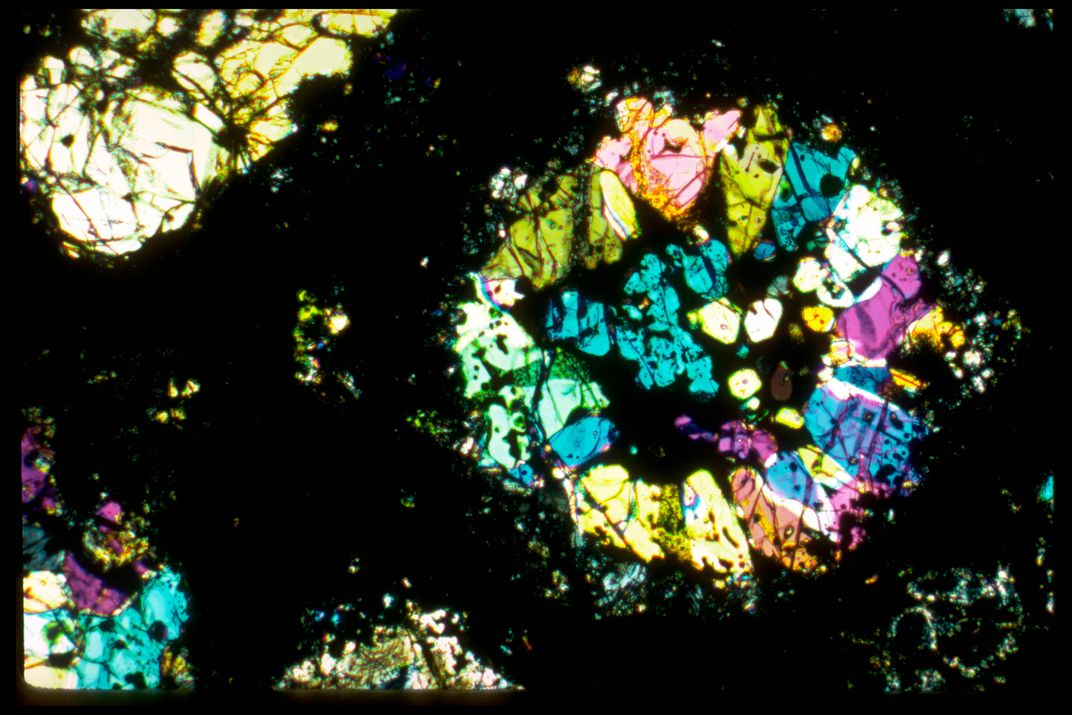The Oldest Material in the Smithsonian Institution Came From Outer Space
Decades after the Allende Meteorite plunged to Earth, scientists still mine its fragments for clues to the cosmos
/https://tf-cmsv2-smithsonianmag-media.s3.amazonaws.com/filer/cd/04/cd04ad6b-99a2-4f32-a980-ccba9bc56baa/janfeb2019_l01_prologue.jpg)
Most likely it came from the asteroid belt, that cosmic junk heap between the orbits of Mars and Jupiter that harbors rubble left over from the Sun’s formation. Plowing into Earth’s atmosphere during the early morning hours of February 8, 1969, the meteor—a stardust memory about the size of a Buick—produced an incandescent blue-white vapor that streaked the sky as a shooting star.
The great ball of fire blazed briefly over the Sierra Madre of Mexico before charging over the Chihuahuan Desert and splintering near the village of Pueblito de Allende, due south of El Paso, Texas. When a meteor smacks down it becomes a meteorite, and this one scattered more than two tons of fragments like birdseed over nearly 100 square miles. With the help of local schoolchildren—who asked for bottles of soda for their efforts—Smithsonian researchers recovered hundreds of specimens, a selection of which are on display at the National Museum of Natural History.
Studded with molten clumps of minerals (chondrules) distributed like currants in a fruitcake, the Allende meteorite, as it came to be known, contains the oldest material in the Smithsonian Institution, or any institution. The ratio of lead and potassium-argon isotopes in this block of mineral components including olivine, pyroxene, feldspar and glass gives it an age of roughly 4.57 billion years, which makes it older than Earth itself. Indeed, it’s the oldest object at our disposal in the solar system.
Our planet is continually bombarded by rocks and extraterrestrial dust; an estimated 25 million meteors enter the atmosphere each day. Of the small percentage to survive the fiery ordeal and pierce Earth’s surface, most fall into the seas. The Allende meteorite wasn’t the most devastating space rock to make land (that honor probably belongs to the asteroid suspected of wiping out the dinosaurs 66 million years ago), or the biggest single chunk (that may be Hoba, the 66-tonner that arrived 80,000 years ago in what is now Namibia) or even the biggest of modern times (a super-sized one dubbed Tunguska ruptured over Russia in 1908 and incinerated 800 square miles of forest). But it’s surely the most scientifically significant, a rich fund of information about the evolution of the gas and dust cloud—the solar nebula—that coalesced into the Sun and planets.
Having fallen on the eve of the Apollo 11 Moon landing, the Allende meteorite may also be the world’s most comprehensively studied rock. For nearly a decade, planetary scientists had been prepping for the arrival of lunar samples, perfecting their analytical technology with new instruments designed to measure everything from radioactive decay to elemental composition.

Today, even as Smithsonian scientists conduct ongoing analysis of the meteorite, they are also the source of Allende investigations on an international scale; they lend micro slices of the meteorite to researchers worldwide. “We love being able to loan out the materials, so folks can do their own research and these rocks can tell us their stories,” says Cari Corrigan, curator of the meteorite collection.
“The Allende meteorite is a book from outer space filled with primordial minerals and all sorts of stories and secrets,” says Chi Ma, director of the analytical facility at Caltech’s geological and planetary sciences division. Ma is both a meteorist—the designation “meteorologist” was claimed first by weather forecasters—and a nanomineralogist, a term he coined for a scientist who peers into a rock’s tiniest recesses for even tinier particles of minerals and the tiny features within them. Ma has spent much of the last 11 years probing the Allende meteorite.
In his laboratory, he scans an Allende shard with an electron microscope and talks nanomineralogy. “When you examine a meteorite down to micrometers and nanoscales, you can discover clues to what was happening when the rock was formed or when the sample was altered.”
While 5,390 minerals have been identified on Earth to date, only about 65 are thought to have been charter members of the solar nebula—the kind of minerals found in meteorites. “The earliest minerals were formed by condensation from solar gases at high temperatures,” Ma says. “These refractory minerals were the first solid materials in our solar system.” When Ma started studying Allende in January 2007, he adds, “only about 30 refractory minerals were known.” He’s found another 30 or so.
So far, Ma has discovered 19 new minerals embedded in the Allende meteorite, including allendeite, hexamolybdenum, tistarite and kangite. He named his favorite, panguite, after Pan Gu, a giant from Chinese mythology who separated yin from yang to create the earth and the heavens. Half a century after the meteorite made contact with our world, its impact continues to deepen.